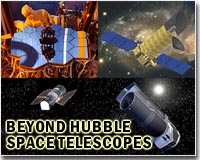 |
London, UK (SPX) Feb 03, 2011 In the quest to discover more about our Universe and the birth of stars and galaxies, a new UK telescope connected for the first time to others across Europe has delivered its first 'radio pictures'. The images of the 3C196 quasar (a black hole in a distant galaxy) were taken in January 2011 by the International LOFAR Telescope (ILT). LOFAR (Low Frequency Array), which is co-ordinated by ASTRON in the Netherlands, is a network of radio telescopes designed to study the sky at the lowest radio frequencies accessible from the surface of the Earth with unprecedented resolution. The UK based telescope at STFC's Chilbolton Observatory in Hampshire, is the western most 'telescope station' in LOFAR. The addition of Chilbolton to other stations in Europe makes the LOFAR array almost 1000 km wide - ten times as large as the original array in the Netherlands - and creates the largest telescope in the world. "This is a very significant event for the LOFAR project and a great demonstration of what the UK is contributing", said Derek McKay-Bukowski, STFC/SEPnet Project Manager at LOFAR Chilbolton. "The new images are three times sharper than has been previously possible with LOFAR. LOFAR works like a giant zoom lens - the more radio telescopes we add, and the further apart they are, the better the resolution and sensitivity. This means we can see smaller and fainter objects in the sky which will help us to answer exciting questions about cosmology and astrophysics." "This is fantastic", said Professor Rob Fender, LOFAR-UK Leader from the University of Southampton. "Combining the LOFAR signals together is a very important milestone for this truly international facility. For the first time, the signals from LOFAR radio telescopes in the Netherlands, France, Germany and the United Kingdom have been successfully combined in the LOFAR BlueGene/P supercomputer in the Netherlands. The connection between the Chilbolton telescope and the supercomputer requires an internet speed of 10 gigabits per second - over 1000 times faster than the typical home broadband speeds," said Professor Fender. "Getting that connection working without a hitch was a great feat requiring close collaboration between STFC, industry, universities around the country, and our international partners." "The images show a patch of the sky 15 degrees wide (as large as a thousand full moons) centred on the quasar 3C196", said Dr Philip Best, Deputy LOFAR-UK leader from the University of Edinburgh. "In visible light, quasar 3C196 (even through the Hubble Space Telescope) is a single point. By adding the international stations like the one at Chilbolton we reveal two main bright spots. This shows how the International LOFAR Telescope will help us learn about distant objects in much more detail." LOFAR was designed and built by ASTRON in the Netherlands and is currently being extended across Europe. As well as deep cosmology, LOFAR will be used to monitor the Sun's activity, study planets, and understand more about lightning and geomagnetic storms. LOFAR will also contribute to UK and European preparations for the planned global next generation radio telescope, the Square Kilometre Array (SKA).
Share This Article With Planet Earth
Related Links Science and Technology Facilities Council Space Telescope News and Technology at Skynightly.com
 Channel island named first 'dark sky' community
Channel island named first 'dark sky' communityLondon (AFP) Jan 31, 2011 The Channel Island of Sark has been designated the first dark sky community in the world in recognition of the lack of light pollution that allows clear views of the stars at night, officials said Monday. The tiny island, located west of France's Cotentin Peninsula and about 80 miles (130 kilometres) off the south coast of England, hopes the designation from the US-based International Dark-S ... read more |
|
| The content herein, unless otherwise known to be public domain, are Copyright 1995-2010 - SpaceDaily. AFP and UPI Wire Stories are copyright Agence France-Presse and United Press International. ESA Portal Reports are copyright European Space Agency. All NASA sourced material is public domain. Additional copyrights may apply in whole or part to other bona fide parties. Advertising does not imply endorsement,agreement or approval of any opinions, statements or information provided by SpaceDaily on any Web page published or hosted by SpaceDaily. Privacy Statement |